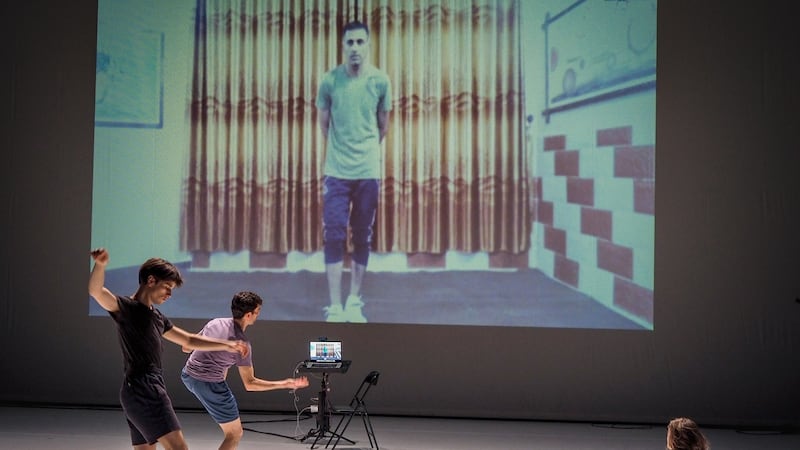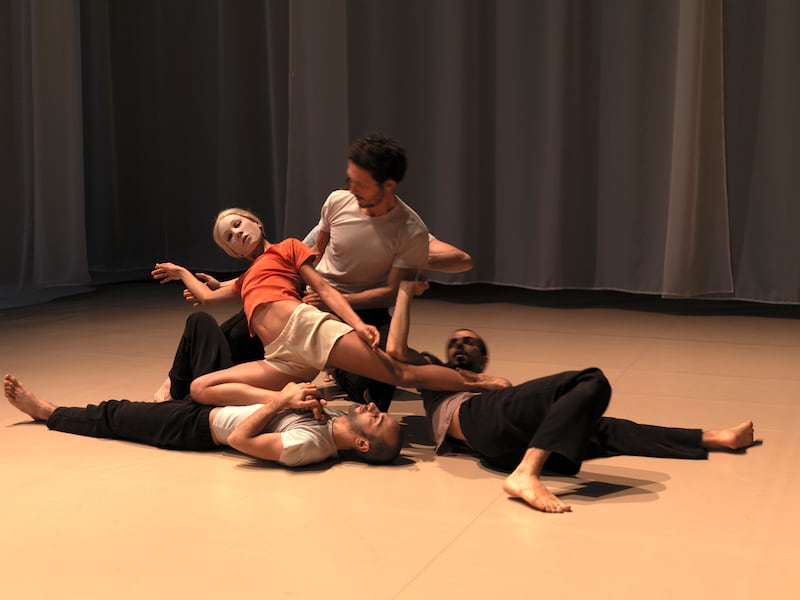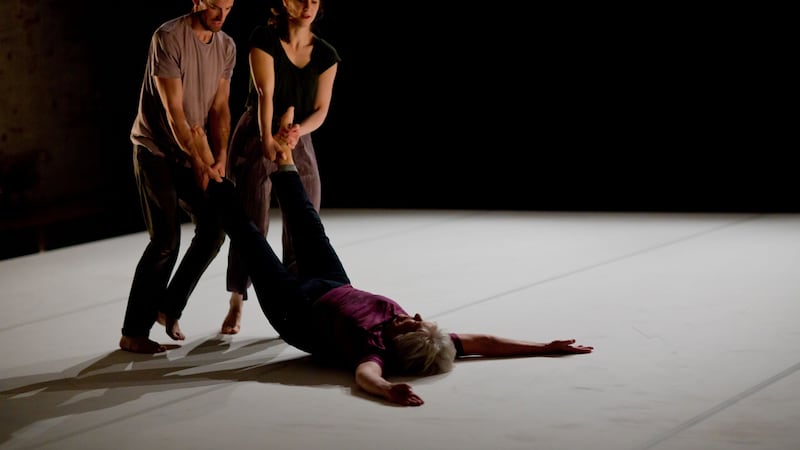There was a highly visual, even cinematic quality to many of the shows and events of the festival, as lighting design, sound and music underlined experiment and collaboration. The partnering of dance and technology revealed both the benign and the darker side of innovation, underscoring contemporary debates, and shows crossed physical and metaphorical borders, revealed the dancing body as archive of memory, as instrument of precision, grace and humanity and as a voice of resistance.
This last was the case in Phoenix (★★★★) which began with three figures dancing their way through a swarm of toy drones buzzing over their heads on stage. The random moves of the hovering drones, gliding and diving, slowly became more intricate, with the dancers’ bodies swooping and bowing low; a game of flying dodgems. But, as the sound escalates, annoyingly insistent, we are reminded of the sounds of surveillance and war.

Choreographer and visual artist Eric Minh Cuong Castaing then transported the audience in real time via Skype, to meet with young dance artists in Gaza where lives are lived under the dark sky of drones. Mumen Kalifa demonstrated a traditional Palestinian folk dance in the constrained and alien environment of his apartment, group of young hip-hop/parkour artists/dancers in a bombed-out building using a drone to film themselves with all the ingenuity and attitude of dispossessed young men everywhere. The bi-location allowed the audience to bear witness to parallel dancing lives struggling to perform, to conserve traditions, to play and to reclaim territory of the body and the spirit.
Experiments
Castaing was also in evidence in a selection of shorts (★★★★) where film became the form to watch further experiments with this partnership of dance.
In his L’Age d’Or, Castaing’s belief in the power of dance as a language of resistance and of healing explored how technology can help bring release from other forms of restraint and struggle. In a tender and joyful visual experience we enter a world of children, constrained through disabilities of the mind and body, being liberated with the the aid of 3D glasses and the support of trained dancers. Perspectives of a world changed inside-out as we saw reimagined duets where children experienced new sensations of stretched and bare limbs, texture and exuberant playfulness.
David Bolger's new short film for Coiscéim, How to Sink a Paper Boat, was made with a gentle playfulness matched with intrigue. It was a light-filled duet with the past, set in a lighthouse on which a moment in history is infused with mystery by dancer Ivonne Lalter and actor Dan Reardon. A tale of lost letters and paper boats where the sunlit water of Dublin Bay is reflected by the rippling score of Michael Fleming.

Light and sound also soared on stage in La Natura Delle Cose (★★★★), "The Nature of Things" from Virgilio Sieni, Italian former architect-turned-choreographer. He drew on the abstracted philosophical world of Lucretius, and his poetic De Rerum Natura/On the Nature of Things – a meditation on life and death from oblivion to oblivion. The white-lit stage was filled with white billowing curtains, transparent but otherworldly, perfect for this meditative and hypnotic work on the cycle of life; an homage to Venus in all phases of life from youth back to birth and on to old age. Ramona Caia created a standout performance as the masked female figure.
Ragdoll
She transformed her body from weightless, graceful ragdoll as she was borne aloft by four over-attentive young bearded acolytes, through moments as in a dream where she is shadowed by the giant puppet white hand of god/creator that looms grotesquely like a giant in a fairy tale. Spoken lines in Italian from the original poem were scattered through the work, weaving seamlessly with the lighting and the ethereal score which breathed rather than sounded – except for the claps of thunder announcing the beginning of life. By the end, with no afterlife entertained, she has been returned to nature, her mask now a stag’s head, her female hands wiping tears from her animal eyes.
The recurring festival theme of togetherness and individual separation and union is embodied again in Ensemble (★★★★), an intergenerational celebration of the playfulness and freedom of dance. Choreographers Lucy Boyes and Robbie Synge, based in the Scottish Highlands, created a community of five dancers exploring and revealing potential in the individual and in group-patterned creations for these different movers, from 30 to 70, building on strengths and personalities to make a supportive ensemble of dances and duets.

Inventions (★★★★) from John Scott, reset from its Kilkenny Arts Week premiere, also explored the intergenerational and the archival aspects of the dancing body. Elegant veteran dancer Valda Setterfield shimmered through the often-frenzied and tumbling chaos of highly visceral duets with Oona Doherty in this ramshackle community, where bodies burst into torrents of wonderfully physical dance, teeming with repressed anger and pain and occasional tenderness and delight. There was a desperate cleaving of bodies in duets, and obliterating fatalism in the solos, as performers Ashley Chen, Kevin Coquelard and Mufutau Yusuf sought contact and release. A moment of joy as Setterfield and Doherty simply linked fingers and hands offset the ferocity with a tinge of hope.
Postmodern
There was a relentless ferocity of a different order in the legendary Rosas danst Rosas (★★★★★) from Anne Teresa De Keersmaeker and her company Rosas which closed the festival, a chance for audiences here to see this 1983 postmodern sensation. It was an exercise in spatial and structured movement, essant and hypnotic, with an almost mathematical precision of bodies and tempo. The sublime dancers moved to inner batons and the insistent score of Thierry de Mey and Peter Vermeersch. Sometimes, in perfect unison, they followed the intaking and exhaling of their breathing, rolling sideways in symmetrical lines as though turning in their sleep, gently but synchronised. A wondrously relentless and rhythmic phase as, propped on elbows, hand to chin, their torsos rose and fell in unison and sequentially. Later, laced in brown shoes and unstacking chairs as props, they moved with dangling arms and deft footwork.
But De Keersmaeker’s magic was her intuition and forensic attention to the details, the ordinary and everyday, the tiny gestures; feminine, repetitive and mesmeric, which counterpointed the almost clinical, minimalist, disciplined motion, adding a touch of human warmth.The tugging at a slipped blouse on a shoulder blade, a hand raised to flick through hair, the cupping of a right breast, smoothing a crease in a skirt, all familiar and individually revealing inhibitions, anxieties and flirtatious tendencies.
Images come and go, their small tableaux in rest, but mostly it is the bodies in meticulous motion, like a speeded-up roll of film, the same shot, same light, same pose, enduring images as 100 minutes on stage suddenly evaporated.
A stunningly artistic and utterly uplifting human endeavour.











